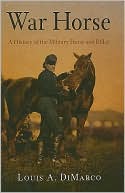

 |

|

The average rating for Warhorse: The Military Horse and Rider based on 2 reviews is 3.5 stars.
Review # 1 was written on 2017-10-22 00:00:00 M S M SI was frankly disappointed - my special interest is European horses and horsemanship in the Middle Ages, and here (Chapter 4: The Knight and His Mount), DiMarco disappoints. He relies nearly exclusively on the outdated sources Davis and Hyland: their axiomatic presumption is that European horse breeding and horsemanship skills were wiped clean with the transition from the Roman Empire to the Germanic successor kingdoms, and required the infusion of Arab know-how and blood-stock following the Moorish invasion of the Iberian Peninsula to set them right again. The problem with this story is that there is no evidence for it, and volumes of archaeological, osteological, DNA and literary evidence against. Unfortunately, DiMarco is limited to English-language sources, so the Middle Ages are confined to the Crusades and the 100 Years' War. He misses the current Spanish archaeological findings demonstrating the high level of Visigoth horse culture prior to the Moorish invasion. He is not familiar with the DNA research, which fails to find Arabian horse DNA in Iberian stock. He reiterates the story of Northern African "Barb" DNA reinvigorating Spanish stock, but forgets that horses were traded across the Straits of Gibraltar for at least a millennium before the Moorish invasion. He has not seen the French and German osteological research, which shows that while post-Roman Empire ovine and bovine breeding skills were lost, equine breeding was preserved and even improved on. The works of Bernard Bachrach might have provided a corrective, and DiMarco does list Bachrach in the literature list, but he is not referenced in the chapter; and certainly, Bachrach's main thesis for the transition from the heavy legionary infantry of the Roman Principate to a multi-role mounted force already from the 4th C onwards would have explained many "mysteries" and avoided fallacies in DiMarco's narrative. DiMarco chooses two battles to illuminate this chapter (14 of the 35 pages): the Battle of the Horns of Hattin, and Crécy; he also references the battle of Tours and Poitiers, but inexplicably sees it as a test of the Frankish horse, though Charles Martel deliberately arrayed the Frankish host dismounted. The battles - though undoubtedly important in terms of military history - are an odd choice for a book on cavalry: It was a series of phenomenally idiotic tactical decisions on the side of the Crusaders that led to the Battle of the Horns of Hattin; deducing general lessons from such a uniquely pathological constellation is not warranted. Also, ultimately, the only units to escape more or less intact were the mounted units around Raymond of Tripoli and Balian of Ibelin. If one wanted to illustrate the differences between Crusader and Saracen cavalry tactics, the battles of Dorylaeum or Arsouf would have been far more instructive, and more typical of mainstream European cavalry usage. The description of the Battle of Crécy is accurate and detailed, but again, it is an odd choice: the dismounted English force succeeded against a disorganised and undisciplined mounted French attack across unsuitable terrain. The fundamental question remains: In a book on the warhorse, in a chapter that purports to illustrate the "supremacy … of heavy cavalry", why highlight a battle where the horse played no role in the victory? It is normally the socialist-leaning historians who revel in tales of the mounted nobility's ineffectiveness. DiMarco could have used Crécy to illustrate the pitfalls of deploying mediaeval cavalry contrary to its tactical doctrine. Set-piece battles were few and far between (as DiMarco correctly states), so using field battle to explain the mediaeval mounted fighter is not only misleading, but misses his key accomplishments. The normal assignments of the knightly "lance" were rapid hit-and-run actions, commando-style raids on enemy supplies, strongholds, mills, crops and other economic infrastructure. In the 35-page chapter, a one-page section at the beginning of the chapter, under "Chevauchée", does acknowledge this (though again confined to English actions during the 100 Years' War); building the chapter around this realisation would have made the sections on horses, horsemanship, tactics, armour, organisation and training (tournaments) fall into place. As an aside, DiMarco heralds Crécy (1346) as the "return of disciplined infantry to the battlefield"; this ignores a consistent string of engagements where disciplined infantry succeeded against cavalry-heavy attacks, from the Battle of Tours and Poitiers in the 8th C to the more recent series of infantry victories including Legnano 1176, the Golden Spurs 1302, Bannockburn 1314, Morgarten 1315, and Laupen 1339. Clearly, DiMarco is a victim of his sources. In his discussions on material culture (stirrups, saddles etc.) he is on firmer ground. As DiMarco confidently explains, and as is consistent with current academic research, progress in the areas of rigging and tack was evolutionary rather than revolutionary. He also confirms the current state of research that puts the height of the mediaeval warhorse at between 14½ and 15 hands, and of medium build - he does not repeat Hyland's inane suggestion that Crusader horses of that height would have weighed in at 1,300 lbs. |
Review # 2 was written on 2014-08-20 00:00:00 Winifred Serfontein Winifred SerfonteinThe best book on cavalry warfare I have ever read. |
CAN'T FIND WHAT YOU'RE LOOKING FOR? CLICK HERE!!!